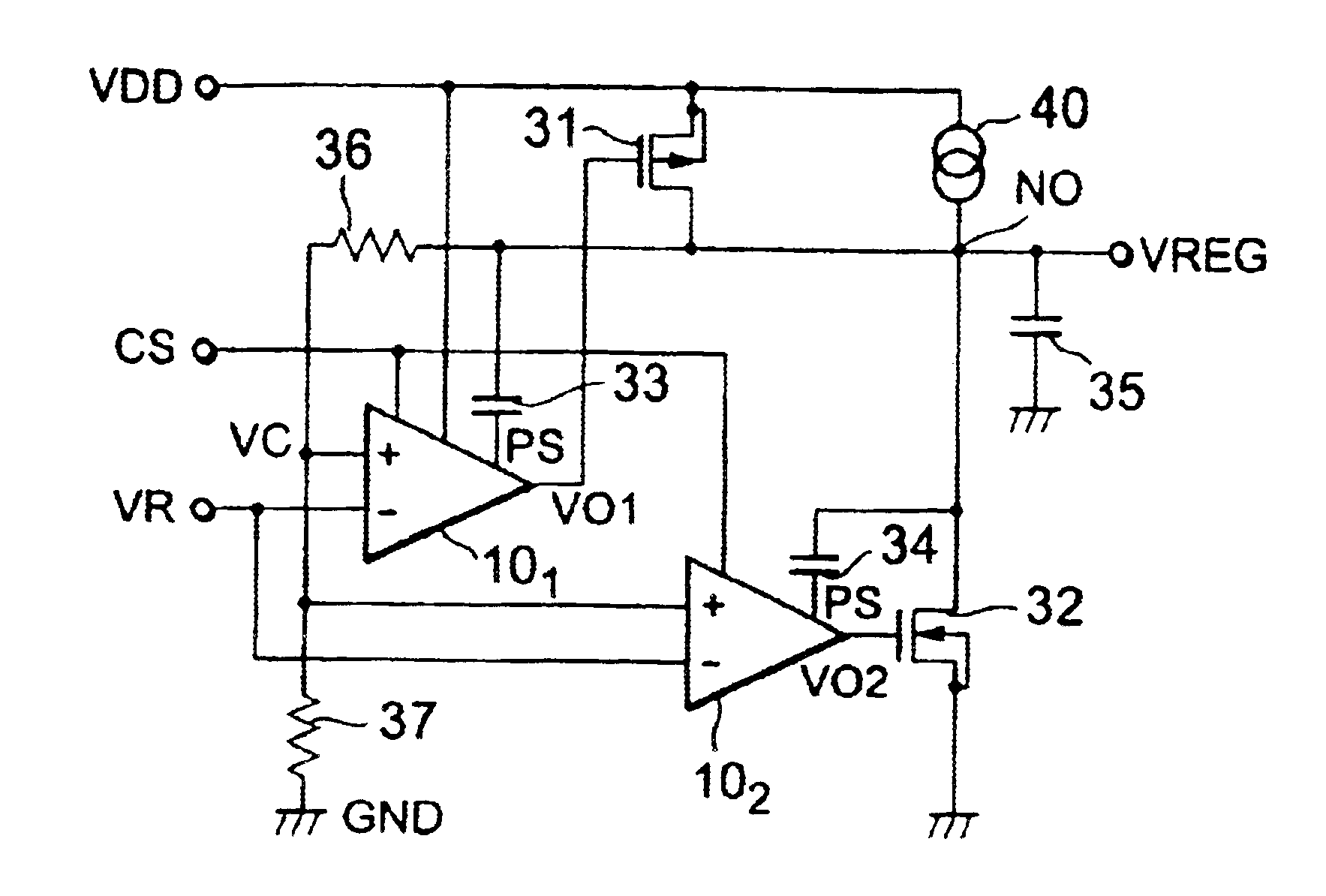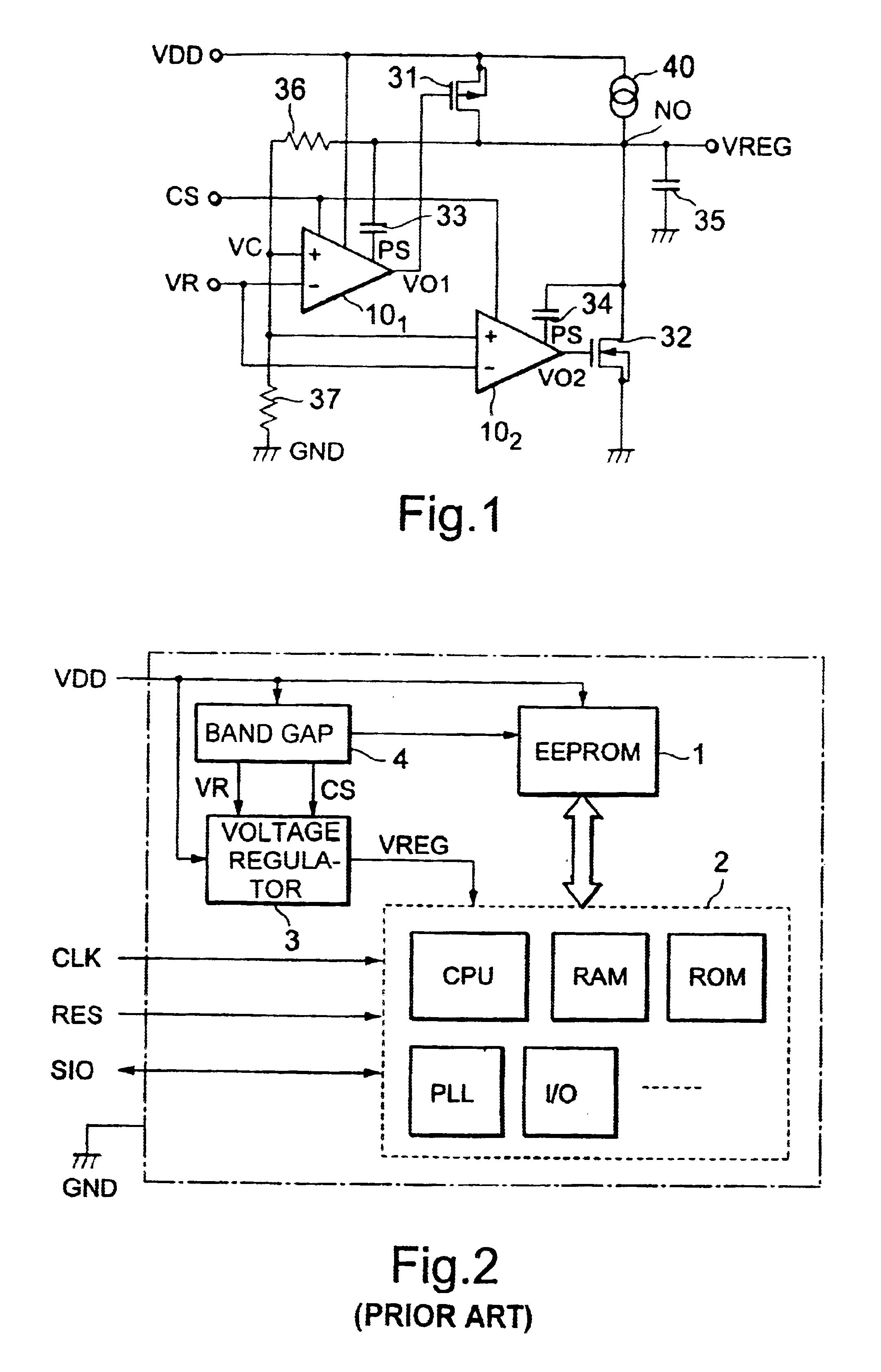Voltage regulator combining a series type regulator with a shunt type regulator having a constant current source
a voltage regulator and constant current technology, applied in the direction of electric variable regulation, process and machine control, instruments, etc., can solve the problems of power consumption, power supply current waveform decoding of secret data which should be protected on security,
- Summary
- Abstract
- Description
- Claims
- Application Information
AI Technical Summary
Benefits of technology
Problems solved by technology
Method used
Image
Examples
first preferred embodiment
[0035]FIG. 1 is a circuit diagram showing a voltage regulator according to a first preferred embodiment of the present invention.
[0036]This voltage regulator has differential type amplification circuit 101 and amplification circuit 102 where a reference voltage VR is applied to an inverted input terminal −, and a comparison voltage VC is given to an non-inverted input terminal +. The amplification circuit 101 and the amplification circuit 102 are the same structures mutually. The output of the amplification circuit 101 is connected to a gate of a P channel MOS transistor 31 (hereinafter referred to as PMOS) and the output of the amplification circuit 102 is connected to a gate of an N channel MOS transistor 32 (hereinafter referred to as NMOS). A source of the PMOS 31 is supplied with the power-supply voltage VDD and a drain of the PMOS 31 is connected to the output node NO. A drain of the NMOS 32 is connected to the output node NO and a source of the NMOS 32 is connected to a groun...
second preferred embodiment
[0062]FIG. 5 is a circuit diagram showing a voltage regulator according to a second preferred embodiment of the present invention. In FIG. 5, wherein like elements are given like reference characters in FIG. 1.
[0063]The difference between the second embodiment and the first embodiment resides in that a resistor 38 is connected between the resistor 36 and the resistor 37. The sum of resistance value of this resistor 36 and resistance value of the resistor 38 is set as the resistance value of the resistor 36 in FIG. 1. The comparison voltage VC1 appeared at a connection point where the resistor 36 and the resistor 38 are connected to each other may be applied to the non-inverted input terminal + of the amplification circuit 101. The comparison voltage VC2 appeared at a connection point where the resistor 37 and the resistor 38 are connected to each other may be applied to the non-inverted input terminal + of the amplification circuit 102.
[0064]The resistance value of the resistor 38 i...
third preferred embodiment
[0072]FIG. 6 is a circuit diagram showing a voltage regulator according to a third preferred embodiment of the present invention. In FIG. 6, wherein like elements are given like reference characters in FIG. 5.
[0073]This voltage regulator is replaced with the amplification circuit 102 in FIG. 5, and has amplification circuit 10A whose operation is controlled by the control signal S1. Moreover, while a PMOS 51 for a switch by which ON / OFF control is carried out with a control signal S1 is provided between the power-supply voltage VDD and the constant current circuit 40 in series, an NMOS 52 for a switch by which ON / OFF control is carried out with this control signal S1 is provided between the output side of amplification circuit 10A, and the ground potential GND. Other structures are the same as that of FIG. 5.
[0074]FIG. 7 is one example of circuit diagram showing an amplifier circuit 10A in FIG. 6. In FIG. 7, wherein like elements are given like reference characters in FIG. 4(a).
[007...
PUM
 Login to View More
Login to View More Abstract
Description
Claims
Application Information
 Login to View More
Login to View More - R&D
- Intellectual Property
- Life Sciences
- Materials
- Tech Scout
- Unparalleled Data Quality
- Higher Quality Content
- 60% Fewer Hallucinations
Browse by: Latest US Patents, China's latest patents, Technical Efficacy Thesaurus, Application Domain, Technology Topic, Popular Technical Reports.
© 2025 PatSnap. All rights reserved.Legal|Privacy policy|Modern Slavery Act Transparency Statement|Sitemap|About US| Contact US: help@patsnap.com



